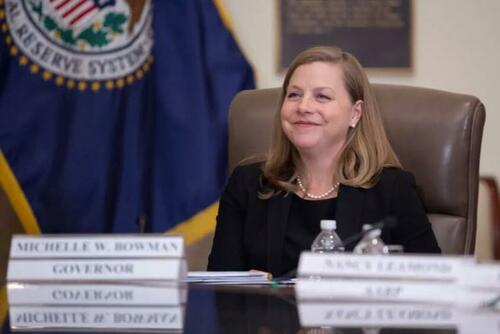Authored by Andrew Moran via The Epoch Times,
The creation of a central bank digital currency (CBDC) presents "significant risks" for the financial system and consumer privacy, says Federal Reserve Governor Michelle Bowman.
Appearing at a Harvard Law School Program on International Financial Systems roundtable on Oct. 17, Ms. Bowman conceded that the benefits of a digital dollar are uncertain and that there could be "unintended consequences" for the banking sector.
"The potential benefits of a U.S. CBDC remain unclear, and the introduction of a U.S. CBDC could pose significant risks and tradeoffs for the financial system," she said in prepared remarks.
"These risks and tradeoffs include potential unintended consequences for the U.S. banking system and considerable consumer privacy concerns."
Ms. Bowman, who is one of seven Federal Reserve Board members overseeing domestic payments systems and banking, averred that she has not come across a "compelling argument" that a CBDC could solve issues surrounding frictions within payment systems, advance financial inclusion, or offer the public access to safe central bank money.
She did agree that the Fed needs to continue researching the subject and obtain greater insights into a digital dollar's technical capabilities and risks associated with CBDCs.
"As the money and payments landscape evolves, I continue to stress the importance of looking ahead and analyzing potential changes that may emerge well into the future," the Fed official noted. "Given the breadth of activity in this space, I believe that policymakers must specify the problems they are trying to solve, understand the range of alternatives that could address any problems, including policy and technology options, and thoroughly analyze the associated risks and tradeoffs."
In July, the central bank launched the FedNow Service, an interbank system for instant payments. Ms. Bowman asserts that this real-time payment service, which allows banks and credit unions to transfer funds instantly for customers, addresses many of the same issues that CBDCs ostensibly need to resolve.
"It is quite possible that other proposed solutions may address many or all of the problems that a CBDC would address, but in a more effective and efficient way," she said.
This is not the first time Ms. Bowman has highlighted various risks by establishing a CBDC.
In April, she told a Georgetown University event that a digital dollar could pose "significant risks, challenges, and tradeoffs" and potentially be an "impediment" to the public's "freedom." Moreover, Fed independence could be undermined if a CBDC results in the "politicization of the payments system and, at its heart, how money is used."
"In thinking about the implications of CBDC and privacy, we must also consider the central role that money plays in our daily lives, and the risk that a CBDC would provide not only a window into, but potentially an impediment to, the freedom Americans enjoy in choosing how money and resources are used and invested," she stated.
The Federal Reserve has yet to decide whether to explore further or install a CBDC. Officials are still in the research and experimentation phases of potentially digitizing the greenback, and Chair Jerome Powell has informed lawmakers that the entity is still a long way from submitting a final decision.
Last year, the New York Fed started a 12-week experiment with several major banks to develop a wholesale CBDC prototype—a digital currency crafted specifically for large-value transactions between financial institutions—and reported that the results "revealed promising applications of blockchain technology" when updating critical payments infrastructure. The regional central bank intended to continually research and develop strategies pertaining to the "future of money and payments from the U.S. perspective."
But while the Fed is still slow to exit the starting gate, the European Central Bank (ECB) appears to be accelerating its CBDC efforts.
